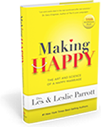This article applies principles from a presentation by Dr. William J. Doherty at the 2000 Denver Smart Marriages conference to stepcouple relationships. You can view a transcript of his entire presentation at the Smart Marriages website.
Stepfamilies don’t have a family tree — they have a family forest! And even without trying, your marriage can easily get lost in the forest (or is it “You can’t see the marriage for the trees”?). So how can you bind together despite the forest’s attempt to pull you apart? One answer is making intentional use of marital rituals.
In a wonderful presentation on marital rituals, Dr. William Doherty of the University of Minnesota defines what rituals are, why they are significant, and how making use of them can hold your marriage together — even strengthen it over time. Here is a summary of his presentation:
Rituals are social interactions that are repeated, coordinated, and emotionally significant to the persons involved. They can be time-intensive behaviors — like one couple’s annual trip on their anniversary to the hotel where they spent their honeymoon — or the simple everyday behaviors that compose our lives — like when I make coffee for my wife in the morning because it “helps her start her day off right.” Routines are things we do on a regular basis, like dropping off the kids at school and watching CSI on Thursday evenings, but may not necessarily be emotionally significant. The key to marital rituals is that they are behaviors that bind the couple together, thus having emotional significance.
Dr. Doherty is correct to point out that rituals of connection bring us together during courtship. We have romantic dinners, long talks, bicycle riding together, walks, gifts, and special ways of saying goodnight each evening. Alas, when the marriage is thrust from exclusive dating into the forest of instant stepfamily living, rituals that connect are often lost. Couples who refuse to get lost in the forest are intentional, conscious, even deliberate about maintaining and sustaining their rituals of connection. Because, as Dr. Doherty points out, if we are not intentional in marriage, we become an “automatic pilot” couple. Couples on auto pilot cannot combat the natural tendency for relationships to lose energy and intimacy over time.
So what does being intentional with marital rituals look like? Here are a few suggestions:
1. Pay attention to your rituals of connection at the beginning and end of the day. Couples often start their marriage with elaborate goodbye/hello kisses and hugs, only to drift into a greeting from across the room that sounds like this: “Hi. Glad you’re home. Could you help Patty with her homework, please?”
At my house, my daily entrance goes something like this: whichever of my three boys who is on the computer near the garage entrance is the first to give me a hug hello. I then take my coat and briefcase into our bedroom and begin looking for my wife. I may have to step over two more boys and a dog before finding her slaving over dinner in the kitchen. I then dismiss any pressing questions from my children in order to warmly hug Nan and practice our “Big Red” kiss (the 30 second kiss they did on the Big Red gum commercials a few years ago). I then change my clothes and start helping with dinner so we can eat as a family. If I don’t find and kiss my wife, we both feel like something is wrong. We feel like something has been lost?and it has.
Make sure your greeting (and “goodbye”) rituals are significant. Don’t miss the opportunity to communicate your single-mindedness about this marriage to both your mate and your children (who are watching your every move).
2. Create and maintain connection rituals that give you focused time together. Some couples strive for “couch time,” the practice of enjoying a cup of coffee together during the evening while sending the children to other rooms to do homework, play games, or chores. Not allowing interruption makes a strong statement and lets you have a few quiet minutes together so you can “check-in” about the day. Other couples have a regular date night away from the children (even part-time children who are only there for the weekend).
Ron’s rules of dating: Don’t discuss issues, problems, children, or money. “Well what else is there?” couples often retort. “That’s the point,” I reply. “None of those things brought you together when you were dating. Don’t let them spoil your connection time now!”
3. Lovemaking is an intimacy ritual that has great significance. Nothing speaks louder of your love and passion for each other than sharing God’s most special gift for married couples. The magic is not in how often you have sex or how many orgasms you have. The magic is in the mystery of two becoming one. Find ways of keeping your lovemaking interesting and alive; but, most of all, bring yourself to the equation and you’ll find it binds you together. (Let me recommend my series on Passionate Sexuality to enhance your understanding of sexuality and God’s gift of sex.)
Like Static Cling
Anyone who has attended a Building A Successful Stepfamily conference has heard me say that couples in stepfamilies must be more intentional about sticking together than couples in first marriages simply because there’s more at work trying to pull you apart. You’ve got to have a “static cling” mentality to brave the stepfamily forest. Being intentional with your rituals helps you stay the course and weather the storms of life. I’m told there’s a sign on an Alaskan highway referring to the snow-packed roads that reads, “Choose your ruts well. You’ll be in them for the next 200 miles.” Marital rituals are ruts that help you stay connected and on-course, even when it’s chilly outside. Choose to be intentional and work at maintaining your rituals, and you’ll find that you are adding significance to your marriage.
Dr. Doherty ended his presentation at the 2000 Smart Marriages conference with these words: “And so, when we cling to each other through our marital rituals, we are set free. Free to risk the uncertainties and pain of conflict, free to explore the astonishing emotional intimacy that only marriage can offer us, knowing that when we cling always, we are free to fly together.”
You can view a transcript of Dr. Doherty’s entire presentation at the Smart Marriages website.
Copyright © 2007 Ron Deal, used with permission. Read more at Successful Step Families



 Ron Deal is a marriage and family author, conference speaker, and therapist. He is founder and president of Smart Stepfamilies™ and director of FamilyLife Blended™, the ministry initiative of FamilyLife® to stepfamilies.
Ron Deal is a marriage and family author, conference speaker, and therapist. He is founder and president of Smart Stepfamilies™ and director of FamilyLife Blended™, the ministry initiative of FamilyLife® to stepfamilies.








